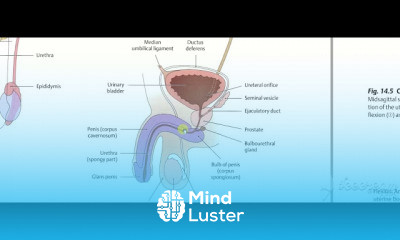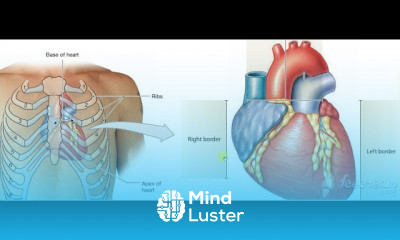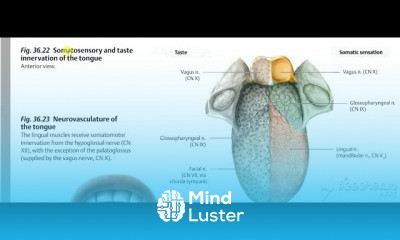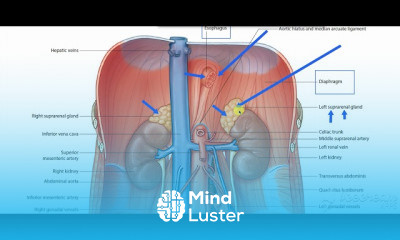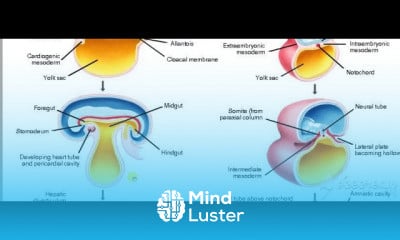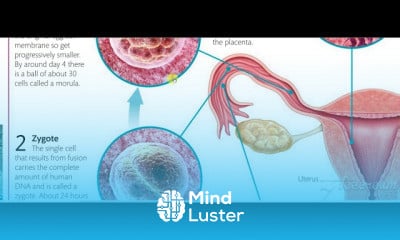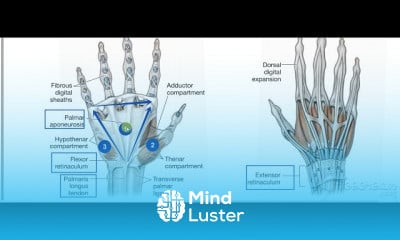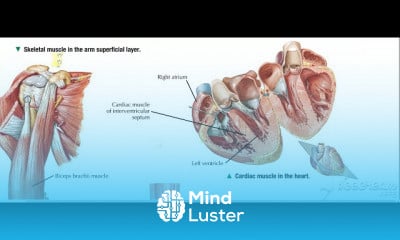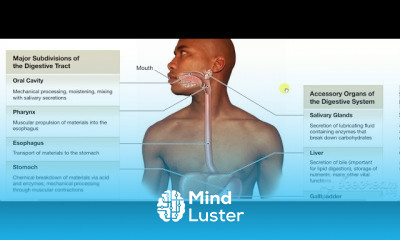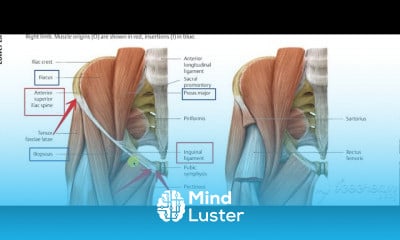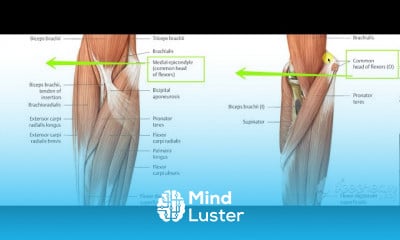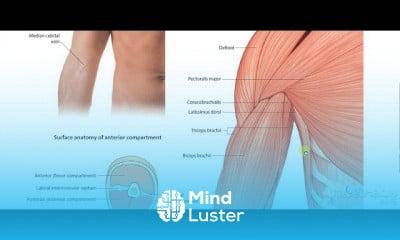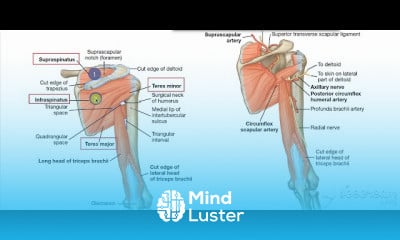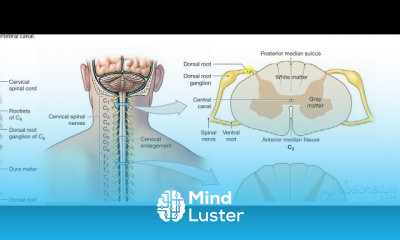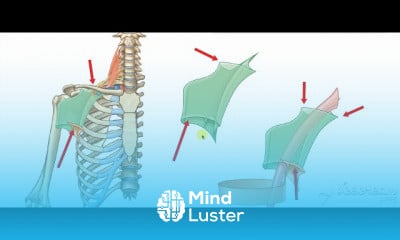Maxillary nerve branches 3
Share your inquiries now with community members
Click Here
Sign up Now
Lessons List | 29
Lesson
Comments
Related Courses in Medical
Course Description
In human anatomy, the pterygopalatine fossa (sphenopalatine fossa) is a fossa in the skull. A human skull contains two pterygopalatine fossae—one on the left side, and another on the right side. Each fossa is a cone-shaped paired depression deep to the infratemporal fossa and posterior to the maxilla on each side of the skull, located between the pterygoid process and the maxillary tuberosity close to the apex of the orbit. It is the indented area medial to the pterygomaxillary fissure leading into the sphenopalatine foramen. It communicates with the nasal and oral cavities, infratemporal fossa, orbit, pharynx, and middle cranial fossa through eight foramina.
The pterygopalatine fossa is a bilateral, cone-shaped depression extending deep from the infratemporal fossa all the way to the nasal cavity via the sphenopalatine foramen.
It is located between the maxilla, sphenoid and palatine bones, and communicates with other regions of the skull and facial skeleton via several canals and foramina. Its small volume combined with the numerous structures that pass through makes this a complex region for anatomy students.
This article will discuss the pterygopalatine fossa, and consider the structures involved according to their respective foramina.
By TeachMeSeries Ltd (2021)
Fig 1.0 - Left infratemoporal fossa demonstrating the opening of the pterygopalatine fossa (circled in red). Note: the zygomatic arch has been removed in this image.
Fig 1.0 – Left infratemoporal fossa demonstrating the opening of the pterygopalatine fossa (circled in red). Note: the zygomatic arch has been removed in this image.
Borders
The borders of the pterygopalatine fossa are formed by the palatine, maxilla and sphenoid bones:
Anterior: Posterior wall of the maxillary sinus.
Posterior: Pterygoid process of the sphenoid bone.
Inferior: Palatine bone and palatine canals.
Superior: Inferior orbital fissure of the eye.
Medial: Perpendicular plate of the palatine bone
Lateral: Pterygomaxillary fissure
Contents
The Pterygopalatine Fossa contains many important neurovascular structures. Here we will discuss the maxillary nerve and its branches, the pterygopalatine ganglion and the maxillary artery and its branches.
Maxillary Nerve
The maxillary nerve is the second branch of the trigeminal nerve (CNV2). It passes from the middle cranial fossa into the pterygopalatine fossa through the foramen rotundum.
The main trunk of the maxillary nerve leaves the pterygopalatine fossa via the infraorbital fissure. Here, it enters the infraorbital canal of the maxilla and exits below the orbit in the infraorbital foramen to contribute to the sensory innervation of the face (figures 2.0 & 2.1).
While in the pterygopalatine fossa, the maxillary nerve gives of numerous branches including the infraorbital, zygomatic, nasopalatine, superior alveolar, pharyngeal and the greater and lesser palatine nerves. The maxillary nerve also communicates with the pterygopalatine ganglion (discussed below) via two small trunks, the pterygopalatine nerves (figure 2.1). These nerves suspend the ganglion within the pterygopalatine fossa.
By TeachMeSeries Ltd (2021)
Fig 3.0 - The main trunk of the maxillary nerve (CNV2); showing the origin at the trigeminal nerve and its path to external facial structures.
Fig 2.0 – The main trunk of the maxillary nerve (CNV2); showing the origin at the trigeminal nerve and its path to external facial structures.
By TeachMeSeries Ltd (2021)
Fig 3.1 - The branches of the pterygopalatine ganglion and the maxillary nerve. Note: For simplicity, this schematic does not show: the contribution of the facial nerve (CNVII) to the pterygopalatine ganglion, the posterior superior alveolar nerves, or the nerve of the pterygoid canal.
Fig 2.1 – The branches of the pterygopalatine ganglion and the maxillary nerve. Note: For simplicity, this schematic does not show: the contribution of the facial nerve (CNVII) to the pterygopalatine ganglion, the posterior superior alveolar nerves, or the nerve of the pterygoid canal.
Pterygopalatine Ganglion
The pterygopalatine ganglion sits deep within the pterygopalatine fossa near the sphenopalatine foramen. It is the largest parasympathetic ganglion related to branches of the maxillary nerve (via pterygopalatine branches) and is predominantly innervated by the greater petrosal branch of the facial nerve (CNVII).
Postsynaptic parasympathetic fibres leave the ganglion and distribute with branches of the maxillary nerve (CNV2). These fibres are secretomotor in function, and provide parasympathetic innervation to the lacrimal gland, and muscosal glands of the oral cavity, nose and pharynx.
By TeachMeSeries Ltd (2021)
Fig 1.2 - The pterygopalatine ganglion and its branches.
Fig 3.0 – The pterygopalatine ganglion and its branches.
Maxillary Artery
The maxillary artery is a terminal branch of the external carotid artery. The terminal portion of the maxillary artery lies within the pterygopalatine fossa. Here, it separates into several branches which travel through other openings within the fossa to reach the regions they supply.
These branches include, but are not limited to:
Sphenopalatine artery (to the nasal cavity).
Descending palatine artery – branches into greater and lesser palatine arteries (hard and soft palates).
Infraorbital artery (lacrimal gland, and some muscles of the eye).
Posterior superior alveolar artery (to the teeth and gingiva).
At their terminal ends, the sphenopalatine and greater palatine arteries anastomose at the nasal septum.
Trends
French
Data Science and Data Preparation
Graphic design tools for beginners
Artificial intelligence essentials
Formation efficace à l écoute de l
Learning English Speaking
Build a profitable trading
Electrical engineering for engineer
MS Excel
Essential english phrasal verbs
American english speaking practice
Build a tic tac Toe app in Xcode
Python for beginners
Figma for UX UI design
Marketing basics for beginners
ArrayLists in C for beginners
Web Design for Beginners
Computer science careers
Certified in CyberSecurity
Magento Formation Français
Recent
Data Science and Data Preparation
Growing ginger at home
Gardening basics
Ancient watering techniques
Grow mushrooms
Growing onions
Veggie growing
Bean growing at home
Growing radishes
Tomato growing at home
Shallot growing
Growing kale in plastic bottles
Recycling plastic barrel
Recycling plastic bottles
Grow portulaca grandiflora flower
Growing vegetables
Growing lemon tree
Eggplant eggplants at home
zucchini farming
watermelon farming in pallets




